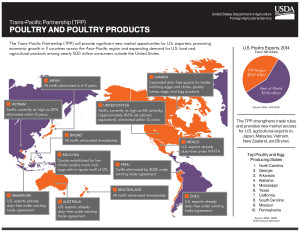Negotiations between the 12 nations included in the Trans Pacific Partnership (TPP) came to a close early Monday morning in Atlanta. The trade agreement must now be approved by the individual nation-states (Australia, Brunei, Canada, Chile, Japan, Malaysia, Mexico, New Zealand, Peru, Singapore, the United States and Vietnam) before it can officially become law.
U.S. Trade Representative Michael Froman noted that Congress would not take up the agreement until 2016, where it would be debated before an up or down vote. Trade Promotion Authority law requires the administration to give the Congress 90 day notice of the final agreement and to publish it 60 days before congressional votes.
“The National Chicken Council applauds U.S. Trade Representative Michael Froman and his team of negotiators for their years of work on the TPP,” said NCC President Mike Brown in a statement released on Monday. “The TPP represents a significant opportunity to expand U.S. chicken exports and bring increased economic benefits to chicken farmers and companies across the country. Our major goals in this deal are to get a strong commitment on enforcement, in particular in the area of sanitary and phytosanitary measures. Second, we hope to see that the long-protected Canadian market is finally opened to free trade for poultry. We look forward to reviewing what we hope will be a commercially meaningful and high standard agreement that will open markets and increase U.S. chicken exports.”
Many industries and business groups are optimistic with regards to the TPP, but have reserved their endorsements of the deal until the text is fully released, and the details can be fully vetted.
USDA’s Foreign Agricultural Service on Thursday issued commodity-by-commodity fact sheets outlining the reductions in tariffs and increases in import quotas negotiated under TPP. While the text of the agreement has not been released, the agency provided the following information about poultry and poultry products under the deal:


